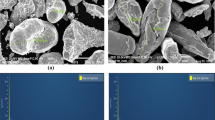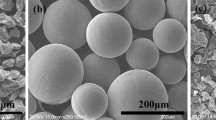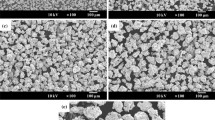Compressibility is one of the most important properties of iron powder for powder metallurgy applications. Understanding effects of chemical impurity elements on compressibility of the iron powder and differentiating contribution of each impurity element are critical for the iron and steel powder enterprise to select approaches to control and improve compressibility of the powder. In this work 500 water-atomized iron powder samples are chosen and effects of the main impurity elements like C, Si, Mn, P, and S and hydrogen loss (HL) reflecting oxygen on compressibility of the iron powder are quantitatively studied. First, effect of single impurity element on the compressibility is investigated. Linear regressions show the degrees of regression are very low even with sample number increase up to 500 implying uncertainty of the single factor regressions due to the instable content of the other impurities when the effect of one impurity element is concentrated on. Then, a multiple factor regression is established taking into account all the six impurity elements as a whole. The degree of regression improves to as high as 0.9746 with sample number increase to 500 and dependency of compact density Y on the six impurity elements can be expressed as: Y = 7.1442 – 0.4231× C% – 0.0498 × Si% – 0.0988 × Mn% – 3.2784 × P% – 0.2577 × S% – 0.1220 × HL%. This equation manifests the negative effects of all the six impurity elements on compressibility of the water-atomized iron powder by P and C mostly, Mn, S, and HL moderately, and Si least.



Similar content being viewed by others

References
D. L. Schaefer and C. J. Trombino, “State of the North American P/M Industry-2004,” Int. J. Powder Metall., 40, 27–32 (2004).
L. Per, “The future of ferrous PM In Europe,” Powder Metall., 47, 6–9 (2004).
Anon, “The Italian PM industry,” Powder Metall., 53, 180–181 (2010).
H. S. Kim, “Densification mechanisms during hot isostatic pressing of stainless steel powder compacts,” J. Mater. Process. Technol., 123, 319–322 (2002).
L. Ramond, G. Bernard-Granger, A. Addad, and C. Guizard, “Sintering of a quasi-crystalline powder using spark plasma sintering and hot-pressing,” Acta Mater., 58, 5120–5128 (2010).
A. Singh and P. S. Harimkar, “Spark plasma sintering of in situ and ex situ iron-based amorphous matrix composites,” J. Alloys Compd., 497, 121–126 (2010).
M. Oghbaei and O. Mirzaee, “Microwave versus conventional sintering: A review of fundamentals, advantages and applications,” J. Alloys Compd., 494, 175–189 (2010).
M. Szanto, W. Bier, N. Frage, et al., “Experimental based finite element simulation of cold isostatic pressing of metal powders,” Int. J. Mech. Sci., 50, 405–421 (2008).
G. Veltl, A. Oppert, and F. Petzoldt, “Warm flow compaction fosters more complex PM parts,” Met. Powder Rep., 56, 26–28 (2001).
J. Z. Wang, H. Q. Yin, X. H. Qu, and J. L. Johnson, “Effect of multiple impacts on high velocity pressed iron powder,” Powder Technol., 195, 184–189 (2009).
I. Aydin, B. J. Briscoe, N. Ozkan, “Modeling powder compaction: A review,” Mater. Res. Soc. Bull., 22, 45-51 (1997).
D. Poquillon, J. Lemaitre, V. Baco-Carles, et al., “Cold compaction of iron powders—relations between powder morphology and mechanical properties. Part I: Powder preparation and compaction,” Powder Technol., 126, 65–74 (2002).
O. Skrinjar and P. L. Larsson, “Cold compaction of composite powders with size ratio,” Acta Mater., 52, 1871–1884 (2004).
S. F. Claeys, “The origins of high compressibility in water atomized iron powder,” Adv. Powder Metall. Part. Mater., 1, 125–138 (1996).
M. Gagne, C. Ciloglu, Y. Trudel, and J. M. Capus, “The influence of residual elements on the green and sintered properties of water-atomized steel powders,” Prog. Powder Metall., 43, 777–787 (1987).
R. H. Hershberger and P. J. McGeehan, “A new higher compressibility iron powder,” Prog. Powder Metall., 42, 305–320 (1986).
H. Sakuma, H. Hanaoka, N. Akegi, et al., “Characteristics of high compressibility atomized iron powder,” Adv. Powder Metall. Part. Mater., 5, 327–336 (1992).
A. G. Bol’shechenko, A. K. Gaiduchenko, I. D. Radomysel’skii, et al., “Effect of some factors on the compressibility of iron powders,” Powder Metall. Met. Ceram., 11, 952–955 (1972).
Acknowlegements
This work was supported by the National Key Technology R&D Program (Project No. 2009BAE74B01), Hunan Provincial Natural Science Foundation of China (Project No.10JJ2037), and Innovation Foundation of State Key Laboratory of Powder Metallurgy, Central South University, China (Project No. 200902) which are sincerely acknowledged.
The authors are also grateful to Dr. Peng Luo from University of Melbourne for his valuable discussions.
Author information
Authors and Affiliations
Corresponding author
Additional information
Published in Poroshkovaya Metallurgiya, Vol. 51, No. 3–4 (484), pp. 19–28, 2012.
Rights and permissions
About this article
Cite this article
Li, S., Yang, Q., Cui, J. et al. Effects of major impurity elements on compressibility of water-atomized iron powder. Powder Metall Met Ceram 51, 142–149 (2012). https://doi.org/10.1007/s11106-012-9409-2
Received:
Published:
Issue Date:
DOI: https://doi.org/10.1007/s11106-012-9409-2



